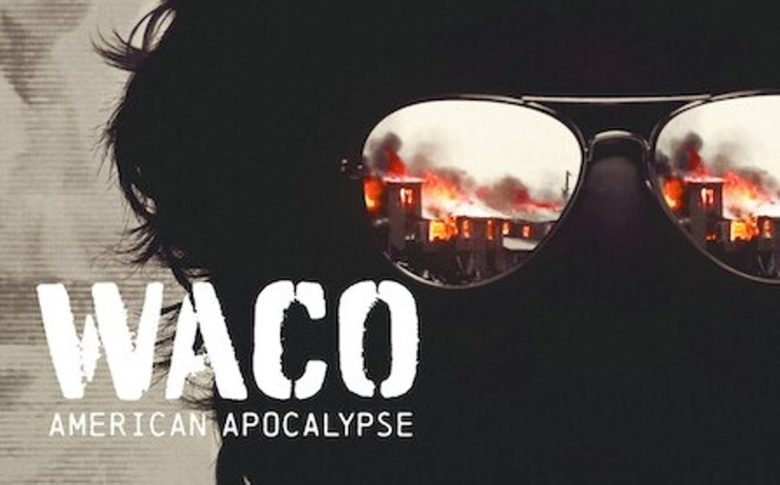Waco: American Apocalypse Review
Waco: American Apocalypse, is a powerful three- part documentary airing on Netflix and directed by Tiller Russell (Night Stalker: The Hunt for a Serial Killer). It uses never before seen archival footage and well-done computer- generated imagery to vividly recreate what happened during the largest gun battle on American soil since the Civil War. The siege lasted 51 days and ended with 82 people dead, including four ATF agents and 25 children. On February 1993, acting on a tip that members of the Branch Davidians were illegally stockpiling and altering automatic weapons, the Bureau of Alcohol, Tobacco, and Firearms (ATF) went to serve a warrant on the group’s sprawling compound. Led by the oddly charismatic David Koresh, who had convinced his followers that he was the Messiah, if not God, the cult was also suspected of child abuse, as Koresh was known to take very young girls for his multiple wives. ATF had planned a surprise raid, but a television news photographer, alerted to the possibility of a breaking story, was attempting to find the compound, which was not actually in Waco, but thirteen miles from it in Mount Carmel. Crossing paths with a rural mailman making deliveries, the photographer asked him for directions, in the process telling him why he was there. Unbeknownst to him, the mailman was a member of the group, and immediately went back to warn them. In the furious shootout that ensued four ATF agents were killed, as were several cult members and multiple others, including Koresh himself, were wounded. It was a terrible beginning to a shocking story that play out on the news for weeks to come.
Waco: American Apocalypse does an excellent job of detailing the raid itself and the devastating events that followed, including the FBI taking over for ATF and the tense back and forth negotiations between Koresh and the FBI. The series makes excellent use of archival news footage and interviews with witnesses to piece together the events so they unfold in a nerve-jangling, continuous fashion. It also showcases videos that Koresh made and that the FBI had recorded, many of which had never been televised before. It shows the tension within the FBI, especially between the hostage negotiation team, which diplomatically tries to persuade Koresh to release his followers, especially the children, and the hostage rescue team, which believed in going in guns blazing to try and end the siege. In interviews with members of both teams, it seems clear that in the ensuing decades neither side has changed their views that the other team’s approach was misguided. Law enforcement made some extremely costly errors, but the series doesn’t dwell on them, nor does it attempt to explain Koresh’s actions. At one point, he was willing to let everyone peacefully leave the compound, but then abruptly changed his mind.
If there’s a fault to be found in the series, it’s the lack of context it provides to the horrific events it so graphically presents. While many Americans are familiar with the broad outlines of what happened during the siege, the passage of thirty years has rendered some of the details hazy. How did the Branch Davidians come to be in Mount Carmel in the first place, and how did they support themselves? Not much background is provided. On the initial day of the raid, who fired first, the ATF or the Branch Davidians? Surviving members of both groups maintain the other side shot first, and the question remains answered. Who actually shot David Koresh? No one is still really sure. What caused the fatal fire to break out on the last day? The FBI maintains the cult members did it intentionally to bring about Koresh’s belief that they would end in sacrificial flames, but a surviving member disputes that. Certainly, there are many questions to be asked about the actions of ATF and the FBI and what, if anything, could have been done to have effected a less catastrophic ending, but the series is content to let the witnesses speak without editorializing. At the end of the series, it is mentioned that Timothy McVeigh was present at Waco and the events there are believed to have galvanized him into committing the Oklahoma City bombings two years later on the same date as the fire. It fails, however, to even begin to discuss the role that Waco is believed to have played in igniting the anti-government, armed-militia resistance that in the succeeding years led to the rise of violent conflicts across the country including the January 6th Capitol attack. But for viewers who believe a good documentary should present the facts as dispassionately as possible and without bias, Waco: American Apocalypse succeeds admirably. At the conclusion of the series a dedication banner runs that says, “For those who died and those who survived” and Waco does its best to honor both, showing often very moving testimonies from news reporters, Koresh’s attorney, the ATF, the FBI and the few surviving Branch Davidians, including the now- grown woman who was the last child to leave the compound alive. Then having presented the facts and shown the footage and shown the interviews, it allows viewers to draw their own conclusions.
Maureen McCabe is a native Southern Californian who enjoys mysteries and thrillers, despite being easily scared.







